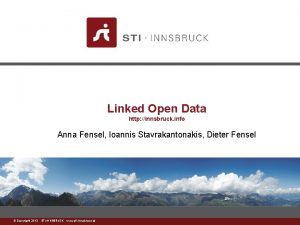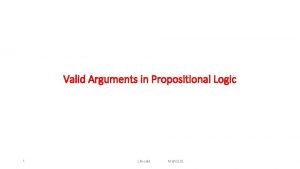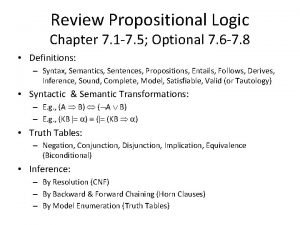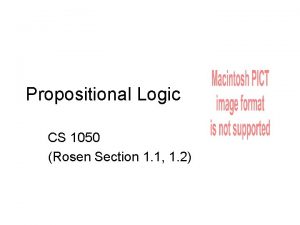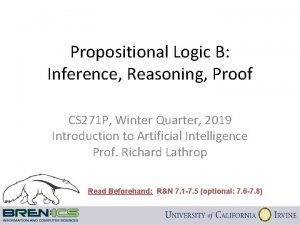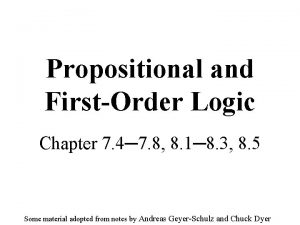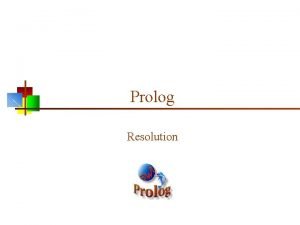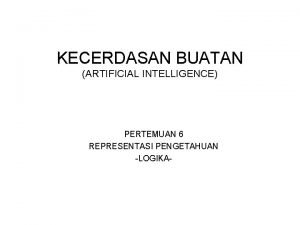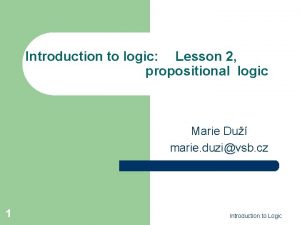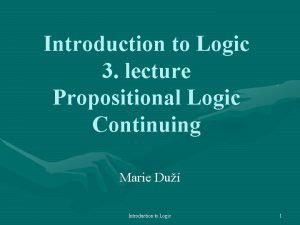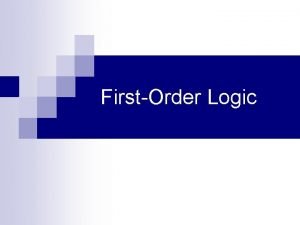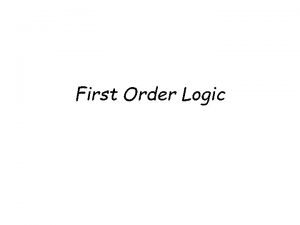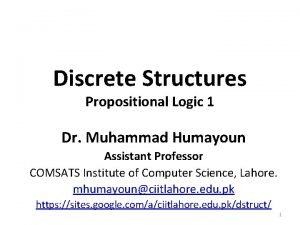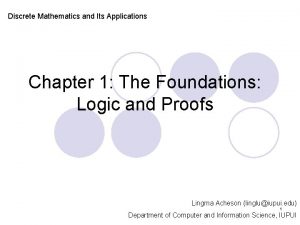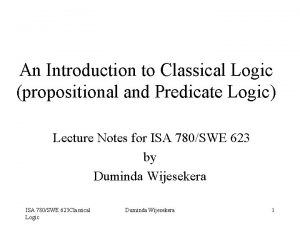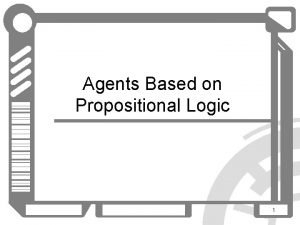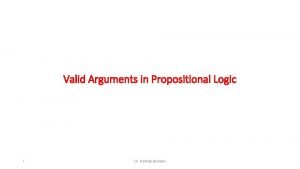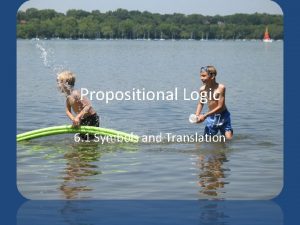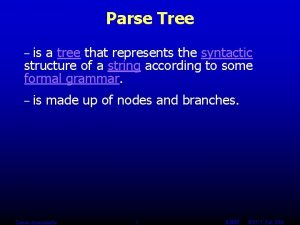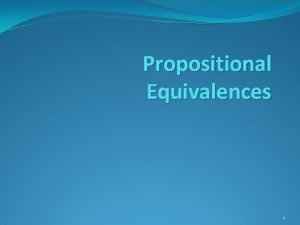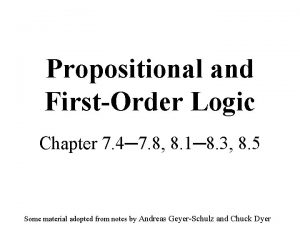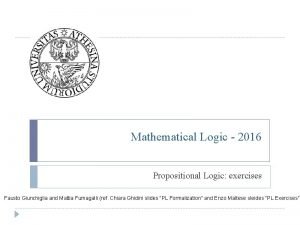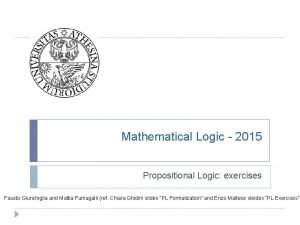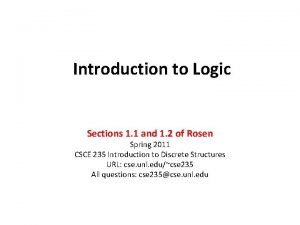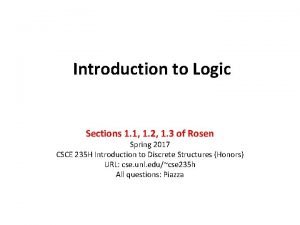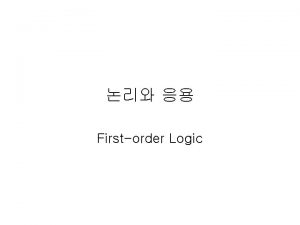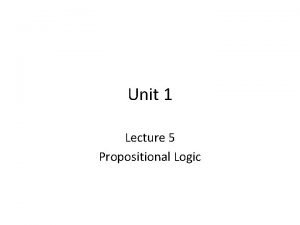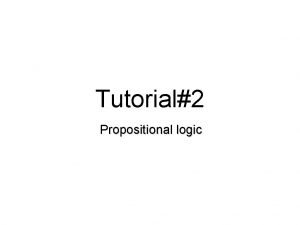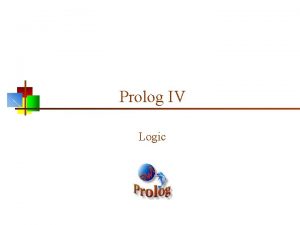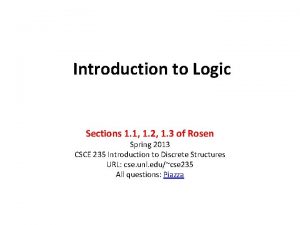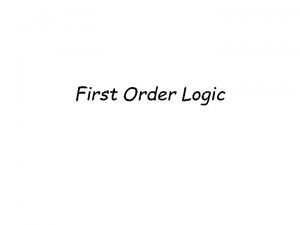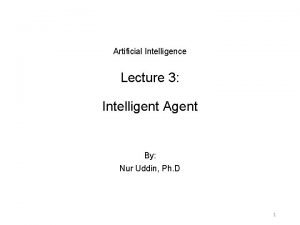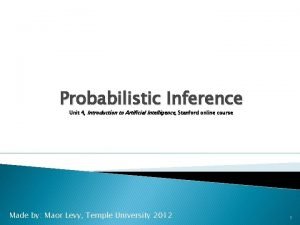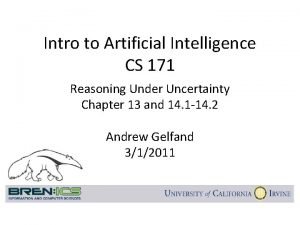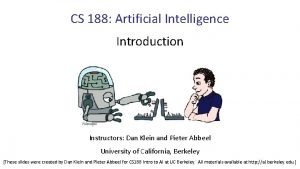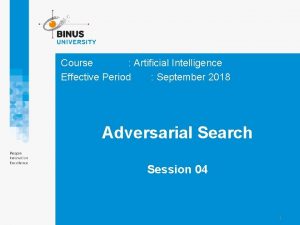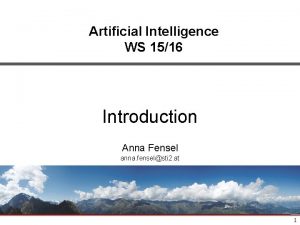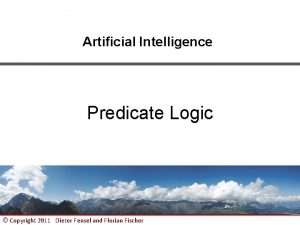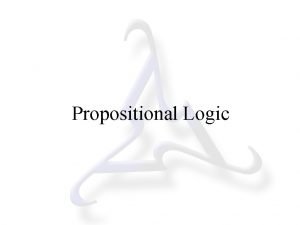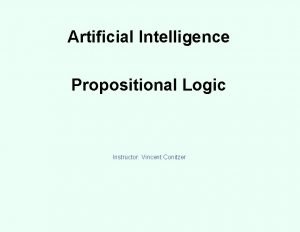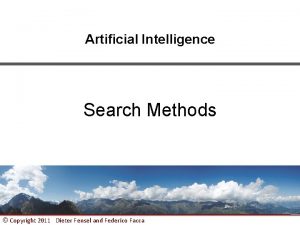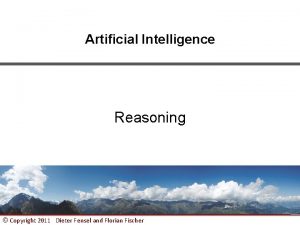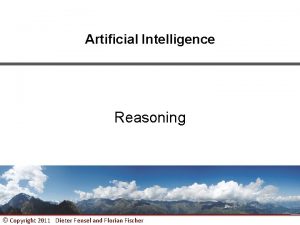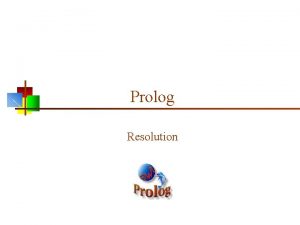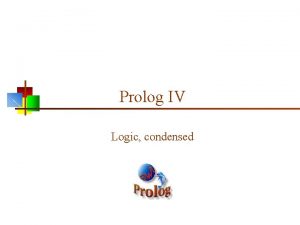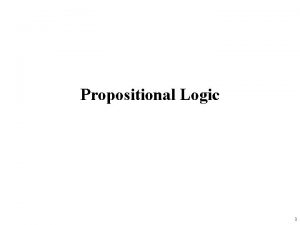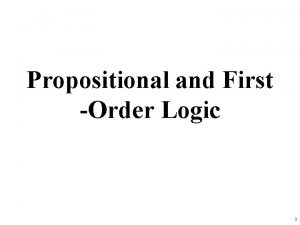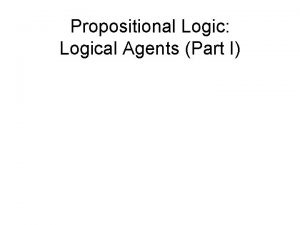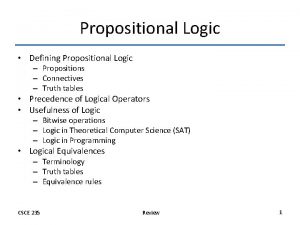Artificial Intelligence Propositional Logic Anna Fensel Copyright 2011









































































- Slides: 73

Artificial Intelligence Propositional Logic Anna Fensel © Copyright 2011 Dieter Fensel and Florian Fischer 1

Where are we? # Title 1 Introduction 2 Propositional Logic 3 Predicate Logic 4 Reasoning 5 Search Methods 6 Common. KADS 7 Problem-Solving Methods 8 Planning 9 Software Agents 10 Rule Learning 11 Inductive Logic Programming 12 Formal Concept Analysis 13 Neural Networks 14 Semantic Web and Services 2

Outline • Motivation • Technical Solution – Syntax – Semantics – Inference • • Illustration by a Larger Example Extensions Summary References 3

MOTIVATION 4 4

Logic and Deduction • Logic is used to formalize deduction • Deduction = derivation of true statements (called conclusions) from statements that are assumed to be true (called premises) • Natural language is not precise, so the careless use of logic can lead to claims that false statements are true, or to claims that a statement is true, even though its truth does not necessarily follow from the premises => Logic provides a way to talk about truth and correctness in a rigorous way, so that we can prove things, rather than make intelligent guesses and just hope they are correct 5

Why Propositional Logic? • Propositional logic is a good vehicle to introduce basic properties of logic; used to: – Associate natural language expressions with semantic representations – Evaluate the truth or falsity of semantic representations relative to a knowledge base – Compute inferences over semantic representations • One of the simplest and most common logic – The core of (almost) all other logics 6

What is Propositional Logic? • An unambiguous formal language, akin to a programming language – Syntax: Vocabulary for expressing concepts without ambiguity – Semantics: Connection to what we're reasoning about • Interpretation - what the syntax means – Reasoning: How to prove things • What steps are allowed 7

TECHNICAL SOLUTIONS 8 8

SYNTAX 9 9

Syntax • • • Logical constants: true, false Propositional symbols: P, Q, S, . . . Wrapping parentheses: ( … ) Atomic formulas: Propositional Symbols or logical constants Formulas are either atomic formulas, or can be formed by combining atomic formulas with the following connectives: . . . and [conjunction] . . . or [disjunction] →. . . implies [implication / conditional] ↔. . is equivalent . . . not [biconditional] [negation] 10

Syntax (cont’) • A sentence (well formed formula) is defined as follows: – – A symbol is a sentence If S is a sentence, then S is a sentence If S is a sentence, then (S) is a sentence If S and T are sentences, then (S T), and (S ↔ T) are sentences – A sentence results from a finite number of applications of the above rules 11

Syntax – BNF Grammar Sentence Atomic. Sentence | Complex. Sentence Atomic. Sentence True | False | P | Q | R |. . . Complex. Sentence (Sentence ) | Sentence Connective Sentence | Sentence Connective | |→|↔ Ambiguities are resolved through precedence → ↔ or parentheses e. g. P Q R S is equivalent to ( P) (Q R)) S 12

Syntax – Examples • • P means “It is hot. ” Q means “It is humid. ” R means “It is raining. ” (P Q) R “If it is hot and humid, then it is raining” • Q P “If it is humid, then it is hot” p q (p q) r p q r ((( p) q) r) « (( r) p) • ( (p q) r • (( p) ( q)) « ( r) • Etc. • • • 13

SEMANTICS 14 14

Semantics • • Interpretations Equivalence Substitution Models and Satisfiability Validity Logical Consequence (Entailment) Theory 15

Semantics – Some Informal Definitions • Given the truth values of all symbols in a sentence, it can be “evaluated” to determine its truth value (True or False) • A model for a KB is a “possible world” (assignment of truth values to propositional symbols) in which each sentence in the KB is True • A valid sentence or tautology is a sentence that is True under all interpretations, no matter what the world is actually like or how the semantics are defined (example: “It’s raining or it’s not raining”) • An inconsistent sentence or contradiction is a sentence that is False under all interpretations (the world is never like what it describes, as in “It’s raining and it’s not raining”) • P entails Q, written P ⊧ Q, means that whenever P is True, so is Q; in other words, all models of P are also models of Q 16

Interpretations • In propositional logic, truth values are assigned to the atoms of a formula in order to evaluate the truth value of the formula • An assignment is a function v : P → {T, F} v assigns a truth value to any atom in a given formula (P is the set of all propositional letters, i. e. atoms) Suppose F denotes the set of all propositional formulas. We can extend an assignment v to a function v : F → {T, F} which assigns the truth value v(A) to any formula A in F. v is called an interpretation. 17

Interpretations (cont’) • Example: – Suppose v is an assignment for which v(p) = F, v(q) = T. – If A = (¬p → q) ↔ (p V q), what is v(A)? Solution: v(A) = v((¬p → q) ↔ (p V q)) = v(¬p → q) ↔ v(p V q) = (v(¬p) → v(q)) ↔ (v(p) V v(q)) = (¬v(p) → v(q)) ↔ (v(p) V v(q)) = (¬F → T) ↔ (F V T) = (T → T) ↔ (F V T) = T↔T = T 18

Equivalence • If A, B are formulas are such that v(A) = v(B) for all interpretations v, A is (logically) equivalent to B: A≡B • Example: ¬p V q ≡ p → q since both formulas are true in all interpretations except when v(p) = T, v(q) = F and are false for that particular interpretation • Caution: ≡ does not mean the same thing as ↔ : – A ↔ B is a formula (syntax) – A ≡ B is a relation between two formula (semantics) Theorem: A ≡ B if and only if A ↔ B is true in every interpretation; i. e. A ↔ B is a tautology. 19

Equivalence and Substitution – Examples • Examples of logically equivalent formulas • Example: Simplify – Solution: 20

Models and Satisfiability • A propositional formula A is satisfiable iff v(A) = T in some interpretation v; such an interpretation is called a model for A. – A is unsatisfiable (or, contradictory) if it is false in every interpretation • A set of formulas U = {A 1, A 2, …, An} is satisfiable iff there exists an interpretation v such that v(A 1) = v(A 2) =…= v(An) = T; such an interpretation is called a model of U. – U is unsatisfiable if no such interpretation exists • Relevant properties: – – If U is satisfiable, then so is U − {Ai} for any i = 1, 2, …, n If U is satisfiable and B is valid, then U U {B} is also satisfiable If U is unsatisfiable and B is any formula, U U {B} is also unsatisfiable If U is unsatisfiable and some Ai is valid, then U − {Ai} is also unsatisfiable 21

Validity • A is valid (or, a tautology), denoted ⊧ A, iff v(A) = T, for all interpretations v • A is not valid (or, falsifiable), denoted ⊭ A if we can find some interpretation v, such that v(A) = F • Relationship between validity, satisfiability, falsifiability, and unsatisfiability: 22

Validity (cont’) • Examples: – Valid (tautology): – Not valid, but satisfiable: – False (contradiction): • Theorem: (a) A is valid if and only if ¬A is unsatisfiable (b) A is satisfiable if and only if ¬A is falsifiable 23

Logical Consequence (i. e. Entailment) • Let U be a set of formulas and A a formula. A is a (logical) consequence of U, if any interpretation v which is a model of U is also a model for A: U⊧A • Example: If some interpretation v is a model for the set , it must satisfy but in this interpretation, we also have 24

Theory • A set of formulas T is a theory if it is closed under logical consequence. This means that, for every formula A, if T ⊧ A, then A is in T • Let U be a set of formulas. Then, the set of all consequences of U T(U) = {A | U ⊧ A} is called theory of U. The formulas in U are called the axioms for theory T(U). 25

INFERENCE 26 26

Inference Methods • Several basic methods for determining whether a given set of premises propositionally entails a given conclusion – Truth Table Method – Deductive (Proof) Systems – Resolution 27

Truth Table Method • One way of determining whether or not a set of premises logically entails a possible conclusion is to check the truth table for the logical constants of the language • This is called the truth table method and can be formalized as follows: – Step 1: Starting with a complete truth table for the propositional constants, iterate through all the premises of the problem, for each premise eliminating any row that does not satisfy the premise – Step 2: Do the same for the conclusion – Step 3: Finally, compare the two tables; If every row that remains in the premise table, i. e. is not eliminated, also remains in the conclusion table, i. e. is not eliminated, then the premises logically entail the conclusion 28

Example • Simple sentences: – Amy loves Pat: loves. Amy. Pat – Amy loves Quincy: loves. Amy. Quincy – It is Monday: ismonday • Premises: – If Amy loves Pat, Amy loves Quincy: loves. Amy. Pat loves. Amy. Quincy – If it is Monday, Amy loves Pat or Quincy: ismonday loves. Amy. Pat loves. Amy. Quincy • Question: – If it is Monday, does Amy love Quincy? i. e. is ismonday loves. Amy. Quincy entailed by the premises? 29

Step 1: Truth table for the premises loves. Amy. Pat loves. Amy. Quincy ismonday loves. Amy. Pat ismonday loves. Amy. Quincy loves. Amy. Pat loves. Amy. Quincy T T T T F T T F F F T T T T F F F F T T 30

Step 1: Eliminate non-sat interpretations loves. Amy. Pat loves. Amy. Quincy ismonday loves. Amy. Pat ismonday loves. Amy. Quincy loves. Amy. Pat loves. Amy. Quincy T T T T F T T F F F T T T T F F F F T T 31

Step 2: Truth table for the conclusion ismonday loves. Amy. Quincy loves. Amy. Pat loves. Amy. Quincy ismonday T T T F T F F T T T F T F F F F T 32

Step 2: Eliminate non-sat interpretations ismonday loves. Amy. Quincy loves. Amy. Pat loves. Amy. Quincy ismonday T T T F T F F T T T F T F F F F T 33

Step 3: Comparing tables • Finally, in order to make the determination of logical entailment, we compare the two rightmost tables and notice that every row remaining in the premise table also remains in the conclusion table. – In other words, the premises logically entail the conclusion. • The truth table method has the merit that it is easy to understand – It is a direct implementation of the definition of logical entailment. • In practice, it is awkward to manage two tables, especially since there are simpler approaches in which only one table needs to be manipulated – Validity Checking – Unsatisfability Checking 34

Validity checking • Approach: To determine whether a set of sentences {j 1, …, jn} logically entails a sentence j, form the sentence (j 1 … jn j) and check that it is valid. • To see how this method works, consider the previous example and write the tentative conclusion as shown below. (loves. Amy. Pat loves. Amy. Quincy) (ismonday loves. Amy. Quincy) • Then, form a truth table for our language with an added column for this sentence and check its satisfaction under each of the possible interpretations for our logical constants 35

Unsatisfability Checking • • • It is almost exactly the same as the validity checking method, except that it works negatively instead of positively. To determine whether a finite set of sentences {j 1, …, jn} logically entails a sentence j, we form the sentence (j 1 … jn j) and check that it is unsatisfiable. Both the validity checking method and the satisfiability checking method require about the same amount of work as the truth table method, but they have the merit of manipulating only one table 36

Example – A truth table r p q p r q (p q) p r q (p r) (p r q) (p q) (p r q) p q T T T F T T F T F T T F F F T F T T T T F F T T T T F F F T T T 37

Deductive (proof) systems • Semantic methods for checking logical entailment have the merit of being conceptually simple; they directly manipulate interpretations of sentences • Unfortunately, the number of interpretations of a language grows exponentially with the number of logical constants. – When the number of logical constants in a propositional language is large, the number of interpretations may be impossible to manipulate. • Deductive (proof) systems provide an alternative way of checking and communicating logical entailment that addresses this problem – In many cases, it is possible to create a “proof” of a conclusion from a set of premises that is much smaller than the truth table for the language; – Moreover, it is often possible to find such proofs with less work than is necessary to check the entire truth table 38

Schemata • An important component in the treatment of proofs is the notion of a schema • A schema is an expression satisfying the grammatical rules of our language except for the occurrence of metavariables in place of various subparts of the expression. – For example, the following expression is a pattern with metavariables j and y. j (y j) • An instance of a sentence schema is the expression obtained by substituting expressions for the metavariables. – For example, the following is an instance of the preceding schema. p (q p) 39

Rules of Inference • The basis for proof systems is the use of correct rules of inference that can be applied directly to sentences to derive conclusions that are guaranteed to be correct under all interpretations – Since the interpretations are not enumerated, time and space can often be saved • A rule of inference is a pattern of reasoning consisting of: – One set of sentence schemata, called premises, and – A second set of sentence schemata, called conclusions • A rule of inference is sound if and only if, for every instance, the premises logically entail the conclusions 40

E. g. Modus Ponens (MP) j y p (q r) p q r raining wet raining wet (p q) r p q r wet slippery wet slippery • I. e. we can substitute for the metavariables complex sentences • Note that, by stringing together applications of rules of inference, it is possible to derive conclusions that cannot be derived in a single step. This idea of stringing together rule applications leads to the notion of a proof. 41

Axiom schemata • The implication introduction schema (II), together with Modus Ponens, allows us to infer implications j (y j) • The implication distribution schema (ID) allows us to distribute one implication over another (j (y c)) ((j y) (j c)) • The contradiction realization schemata (CR) permit us to infer a sentence if the negation of that sentence implies some sentence and its negation (y j) ((y j) y) ( y j) (( y j) y) 42

Axiom schemata (cont’) • The equivalence schemata (EQ) captures the meaning of the ↔ operator (j ↔ y) (j y) (j ↔ y) (y j) (j y) ((y j) (y ↔ j)) • The meaning of the other operators in propositional logic is captured in the following axiom schemata (j y) ↔ (y j) (j y) ↔ ( j y) • The above axiom schemata are jointly called the standard axiom schemata for Propositional Logic – They all are valid 43

Proofs • A proof of a conclusion from a set of premises is a sequence of sentences terminating in the conclusion in which each item is either (1) a premise, (2) an instance of an axiom schema, or (3) the result of applying a rule of inference to earlier items in sequence • Example: 1. p q 2. q r 3. (q r) (p (q r)) 4. p (q r) 5. (p (q r)) (( p q) (p r)) 6. (p q) (p r ) 7. p r Premise II MP : 3, 2 ID MP : 5, 4 MP : 6, 1 44

Proofs (cont’) • If there exists a proof of a sentence j from a set D of premises and the standard axiom schemata using Modus Ponens, then j is said to be provable from D, written as D⊢j • There is a close connection between provability and logical entailment (⊧): A set of sentences D logically entails a sentence j if and only if j is provable from D • Soundness Theorem: If j is provable from D, then D logically entails j. • Completeness Theorem: If D logically entails j, then j is provable from D. 45

Proofs (cont’) • The concept of provability is important because it suggests how we can automate the determination of logical entailment – Starting from a set of premises D, we enumerate conclusions from this set – If a sentence j appears, then it is provable from D and is, therefore, a logical consequence – If the negation of j appears, then j is a logical consequence of D and j is not logically entailed (unless D is inconsistent) – Note that it is possible that neither j nor j will appear 46

Resolution • Propositional resolution is an extremely powerful rule of inference for Propositional Logic • Using propositional resolution (without axiom schemata or other rules of inference), it is possible to build a theorem prover that is sound and complete for all of Propositional Logic • The search space using propositional resolution is much smaller than for standard propositional logic • Propositional resolution works only on expressions in clausal form – Before the rule can be applied, the premises and conclusions must be converted to this form 47

Clausal Forms • A clause is a set of literals which is assumed (implicitly) to be a disjunction of those literals – Example: • Unit clause: clause with only one literal; e. g. {¬q} • Clausal form of a formula: Implicit conjunction of clauses • Example: Abbreviated notation: • Notation: – l-literal, lc-complement of l – C-clause (a set of literals) – S-a clausal form (a set of clauses) 48

Resolution – Properties of Clausal Forms (1) If l appears in some clause of S, but lc does not appear in any clause, then, if we delete all clauses in S containing l, the new clausal form S' is satisfiable if and only if S is satisfiable Example: Satisfiability of is equivalent to satisfiability of (2) Suppose C = {l} is a unit clause and we obtain S' from S by deleting C and lc from all clauses that contain it; then, S is satisfiable if and only if S' is satisfiable Example: is satisfiable iff is satisfiable 49

Resolution – Properties of Clausal Forms (cont’) (3) If S contains two clauses C and C', such that C is a subset of C', we can delete C‘ without affecting the (un)satisfiability of S Example: is satisfiable iff is satisfiable (4) If a clause C in S contains a pair of complementary literals l, lc, then C can be deleted from S without affecting its (un)satisfiability Example: is satisfiable iff is such 50

Converting to clausal form Theorem: Every propositional formula can be transformed into an equivalent formula in CNF 1. Implications: j 1 j 2 j 1 ↔ j 2 ( j 1 j 2 ) (j 1 j 2) 2. Negations: j j (j 1 j 2 ) j 1 j 2 3. Distribution: j 1 (j 2 j 3 ) (j 1 j 2) (j 1 j 3 ) (j 1 j 2) j 3 (j 1 j 3 ) (j 2 j 3) (j 1 j 2) j 3 j 1 (j 2 j 3) 4. Operators: j 1 . . . jn {j 1, . . . , jn} j 1 . . . jn {j 1}. . . {jn} 51

Example • Transform the formula (p → q) → (¬q → ¬p) into an equivalent formula in CNF Solution: 52

Resolution Rule • Suppose C 1, C 2 are clauses such that l in C 1, lc in C 2. The clauses C 1 and C 2 are said to be clashing clauses and they clash on the complementary literals l, lc C, the resolvent of C 1, C 2 is the clause C 1 and C 2 are called the parent clauses of C. 53

Resolution Rule (cont’) • Example: The clauses clash on C 1, C 2 also clash on so, another way to find a resolvent for these two clauses is 54

Resolution (cont’) • • Theorem: Resolvent C is satisfiable if and only if the parent clauses C 1, C 2 are simultaneously satisfiable Resolution Algorithm: Input: S – a set of clauses Output: “S is satisfiable” or “S is not satisfiable” 1. Set S 0 : = S 2. Suppose Si has already been constructed 3. To construct Si+1, choose a pair of clashing literals and clauses C 1, C 2 in S (if there any) and derive C : = Res(C 1, C 2) Si+1 : = Si U {C} 1. If C is the empty clause, output “S is not satisfiable”; if Si+1 = Si , output “S is satisfiable” 2. Otherwise, set i : = i + 1 and go back to Step 2 55

Resolution (cont’) • Example: Show that (p → q) → (¬q → ¬p) is a valid formula Solution: We will show that ¬[(p → q) → (¬q → ¬p)] is not satisfiable. (1) Transform the formula into CNF: (2) Show, using resolution, that 1. 2. 3. • C is the empty clause A derivation of the empty clause from S is called a refutation of S 56

Resolution (cont’) • Theorem: If the set of a clauses labeling the leaves of a resolution tree is satisfiable, then the clause at the root is satisfiable • Theorem (Soundness): If the empty clause is derived from a set of clauses, then the set of clauses is unsatisfiable • Theorem (Completeness) If a set of clauses is unsatisfiable, then the empty clause can be derived from it using resolution algorithm 57

ILLUSTRATION BY LARGER EXAMPLE 58 58

Problem Example • For each of these sets of premises, what relevant conclusion or conclusions can be drawn? Explain the rules of inference used to obtain each conclusion from the premises. (a) “If I eat spicy foods, then I have strange dreams. ” “I have strange dreams if there is thunder while I sleep. ” “I did not have strange dreams. ” (b) “I am dreaming or hallucinating. ” “I am not dreaming. ” “If I am hallucinating, I see elephants running down the road. ” (c) “If I work, it is either sunny or partly sunny. ” “I worked last Monday or I worked last Friday. ” “It was not sunny on Tuesday. ” “It was not partly sunny on Friday. ” 59

Solution (a) “If I eat spicy foods, then I have strange dreams. ” “I have strange dreams if there is thunder while I sleep. ” “I did not have strange dreams. ” • The relevant conclusions are: “I did not eat spicy food” and “There is no thunder while I sleep”. • Let the primitive statements be: – s, ‘I eat spicy foods’ – d, ‘I have strange dreams’ – t, ‘There is thunder while I sleep’ • • • 1. 2. 3. 4. 5. Then the premises are translated as: s → d, t → d, and ¬d. And the conclusions: ¬s, ¬t. Steps Reason s→d premise ¬s Modus Tollens to Steps 1 and 2 t→d premise ¬t Modus Tollens to Steps 4 and 2. 60

Solution (b) “I am dreaming or hallucinating. ” “I am not dreaming. ” “If I am hallucinating, I see elephants running down the road. ” • The relevant conclusion is: “I see elephants running down the road. ”. • Let the primitive statements be: – d, ‘I am dreaming’ – h, ‘I am hallucinating’ – e, ‘I see elephants running down the road’ • • • 1. 2. 3. 4. 5. Then the premises are translated as: d ∨ h, ¬d, and h → e. And the conclusion: e. Steps Reason d∨h premise ¬d premise h rule of disjunctive syllogism to Steps 1 and 2 h→e premise e Modus Ponens to Steps 4 and 3 61

Solution (c) “If I work, it is either sunny or partly sunny. ” “I worked last Monday or I worked last Friday. ” “It was not sunny on Tuesday. ” “It was not partly sunny on Friday. ” • There is no single relevant conclusion in this problem, its main difficulty is to to represent the premises so that one is able infer anything at all. One possible relevant conclusion is: “It was sunny or partly sunny last Monday or it was sunny last Friday. ”. • Let the primitive statements be: – wm, ‘I worked last Monday’ – wf , ‘I worked last Friday’ – sm, ‘It was sunny last Monday’ – st, ‘It was sunny last Tuesday’ – sf , ‘It was sunny last Friday’ – pm, ‘It was partly sunny last Monday’ – pf , ‘It was partly sunny last Friday’ • Then the premises are translated as: wm ∨ wf , wm → (sm ∨ pm), wf → (sf ∨ pf ), ¬st, and ¬pf. • And the conclusion: sf ∨ sm ∨ pm. 62

Solution (c) – Method 1 • Steps 1. wf → (sf ∨ pf ) 2. ¬wf ∨ sf ∨ pf 3. ¬pf → (¬wf ∨ sf ) 4. ¬pf 5. ¬wf ∨ sf 6. wf → sf 7. wm ∨ wf 8. ¬wm → wf 9. ¬wm → sf 10. wm ∨ sf 11. ¬sf → wm 12. wm → (sm ∨ pm) 13. ¬sf → (sm ∨ pm) 14. sf ∨ sm ∨ pm Reason premise expression for implication premise modus ponens to Steps 3 and 4 expression for implication premise expression for implication rule of syllogism to Steps 8 and 6 expression for implication premise rule of syllogism to Steps 11 and 12 expression for implication. 63

Solution (c) – Method 2 (Use the rule of resolution) • 1. 2. 3. 4. 5. 6. 7. 8. 9. Steps wf → (sf ∨ pf ) ¬wf ∨ sf ∨ pf ¬wf ∨ sf wm ∨ wf wm ∨ sf wm → (sm ∨ pm) ¬wm ∨ sm ∨ pm sf ∨ sm ∨ pm Reason premise expression for implication premise rule of resolution to Steps 2 and 3 premise rule of resolution to Steps 4 and 5 premise expression for implication rule of resolution to Steps 7 and 8 64

EXTENSIONS 65 65

Extensions • Propositional logic is not adequate formalizing valid arguments that rely on the internal structure of the propositions involved • In propositional logic the smallest atoms represent whole propositions (propositions are atomic) – Propositional logic does not capture the internal structure of the propositions – It is not possible to work with units smaller than a proposition • Example: – “A Mercedes Benz is a Car” and “A car drives” are two individual, unrelated propositions – We cannot conclude “A Mercedes Benz drives” 66

Extensions • It is possible to represent everything you want in propositional logic – But often this is not very efficient • Basic idea: A proposition is expressed as predicate about (on or more) objects in the world • Propositions are predicates and arguments – I. e. Car(Mercedes Benz). • The most immediate way to develop a more complex logical calculus is to introduce rules that are sensitive to more fine-grained details of the sentences being used – When the atomic sentences of propositional logic are broken up into terms, variables, predicates, and quantifiers, they yield first-order logic, which keeps all the rules of propositional logic and adds some new ones 67

SUMMARY 68 68

Summary • Propositional logic is one of the simplest and most common logic and is the core of (almost) all other logics – Propositional logic commits only to the existence of facts that may or may not be the case in the world being represented – Propositional logic quickly becomes impractical, even for very small worlds • This lecture focused on three core aspects of the propositional logic: – Syntax: Vocabulary for expressing concepts without ambiguity – Semantics: Connection to what we're reasoning about • Interpretation - what the syntax means – Reasoning: How to prove things • What steps are allowed 69

REFERENCES 70 70

References • Mandatory Reading: – First-Order Logic and Automated Theorem Proofing (2 nd edition) by Melvin Fitting • Further Reading: – Mathematical Logic for Computer Science (2 nd edition) by Mordechai Ben-Ari • http: //www. springer. com/computer/foundations/book/978 -1 -85233319 -5 – Propositional Logic at The Internet Encyclopedia of Philosophy • http: //www. iep. utm. edu/p/prop-log. htm • Wikipedia links: – http: //en. wikipedia. org/wiki/Propositional_calculus 71

Next Lecture # Title 1 Introduction 2 Propositional Logic 3 Predicate Logic 4 Reasoning 5 Search Methods 6 Common. KADS 7 Problem-Solving Methods 8 Planning 9 Agents 10 Rule Learning 11 Inductive Logic Programming 12 Formal Concept Analysis 13 Neural Networks 14 Semantic Web and Services 72

Questions? 73
 Anna fensel
Anna fensel First order logic vs propositional logic
First order logic vs propositional logic First order logic vs propositional logic
First order logic vs propositional logic First order logic vs propositional logic
First order logic vs propositional logic Inference in first order logic
Inference in first order logic Arguments in logic
Arguments in logic Propositional logic examples
Propositional logic examples Negation math
Negation math Xor in propositional logic
Xor in propositional logic Propositional logic notation
Propositional logic notation Implies in propositional logic
Implies in propositional logic Propositional logic
Propositional logic Propositional logic adalah
Propositional logic adalah Well formed formula
Well formed formula Propositional logic notation
Propositional logic notation Pros and cons of propositional logic
Pros and cons of propositional logic Logic
Logic Discrete math propositional logic
Discrete math propositional logic Applications of propositional logic in discrete mathematics
Applications of propositional logic in discrete mathematics De morgan's law in propositional logic
De morgan's law in propositional logic The proposition ~p ν (p ν q) is a
The proposition ~p ν (p ν q) is a Reflexive axiom
Reflexive axiom Agents based on propositional logic
Agents based on propositional logic Valid arguments in propositional logic
Valid arguments in propositional logic Compound statement symbols
Compound statement symbols Parse tree example
Parse tree example Logical equivalence
Logical equivalence Horn clause
Horn clause Propositional logic exercises
Propositional logic exercises Propositional logic exercises
Propositional logic exercises Logical equivalence
Logical equivalence Propositional logic cheat sheet
Propositional logic cheat sheet ___________ is the limitation of propositional logic
___________ is the limitation of propositional logic Aima slides
Aima slides Simple proposition
Simple proposition Propositional logic examples and solutions
Propositional logic examples and solutions Propositional logic
Propositional logic Propositional logic
Propositional logic Uniqueness quantifier equivalence
Uniqueness quantifier equivalence Decision support system
Decision support system Expert system
Expert system Breadth first search prolog
Breadth first search prolog Searching for solutions in artificial intelligence
Searching for solutions in artificial intelligence 15-780 graduate artificial intelligence
15-780 graduate artificial intelligence Knowledge manipulation in artificial intelligence
Knowledge manipulation in artificial intelligence Procedural knowledge in ai
Procedural knowledge in ai American association for artificial intelligence 17 mar
American association for artificial intelligence 17 mar Artificial intelligence leadership
Artificial intelligence leadership Artificial intelligence assessment
Artificial intelligence assessment Math and artificial intelligence
Math and artificial intelligence Peas in ai examples
Peas in ai examples 15-780 graduate artificial intelligence
15-780 graduate artificial intelligence Xkcd deep learning
Xkcd deep learning Inference rules for fuzzy propositions
Inference rules for fuzzy propositions Cse 571
Cse 571 15-780 graduate artificial intelligence
15-780 graduate artificial intelligence Informed and uninformed search
Informed and uninformed search What is artificial intelligence class 6
What is artificial intelligence class 6 Levels of language analysis
Levels of language analysis Omniscience in artificial intelligence
Omniscience in artificial intelligence What is the alan turing test
What is the alan turing test Artificial intelligence chapter 3
Artificial intelligence chapter 3 Semantic network in ai
Semantic network in ai A* vs ao* algorithm
A* vs ao* algorithm Artificial intelligence thesis proposals
Artificial intelligence thesis proposals Rule based deduction system in artificial intelligence
Rule based deduction system in artificial intelligence Inference by enumeration in artificial intelligence
Inference by enumeration in artificial intelligence Learning in ai
Learning in ai Water jug problem in artificial intelligence
Water jug problem in artificial intelligence Pxdes expert system
Pxdes expert system Optimal decisions in games in artificial intelligence
Optimal decisions in games in artificial intelligence Hbr ai and machine learning
Hbr ai and machine learning Cs 188
Cs 188 Optimal decisions in games in artificial intelligence
Optimal decisions in games in artificial intelligence
